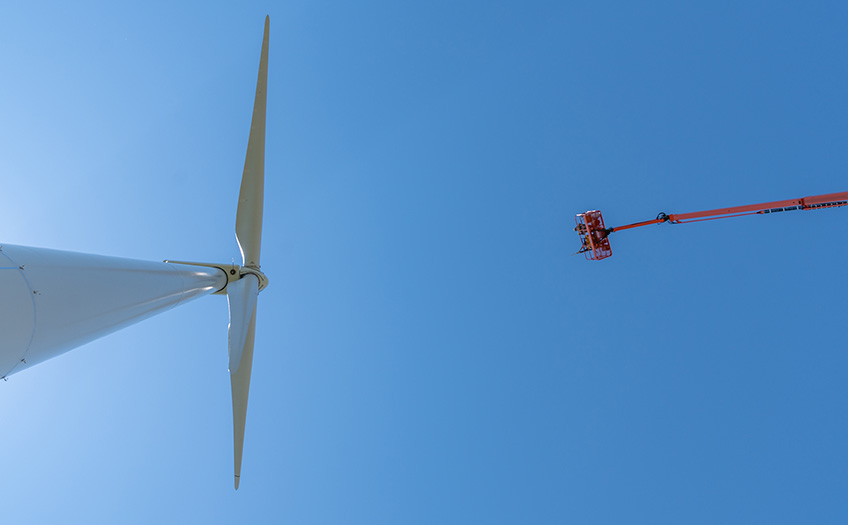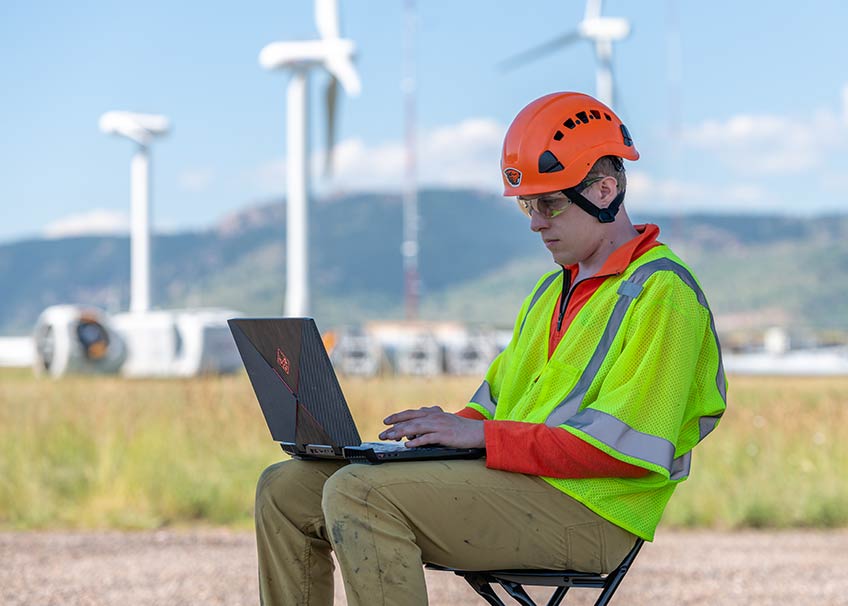Oregon State University Partners with NREL To Improve Wildlife Impact Minimization System
A surprising combination of sophisticated sensor technology, tennis balls, a potato gun, and a novel deterrent device could hold the answers to preventing eagles from encountering wind turbines. Oregon State University (OSU) researchers visited NREL’s Flatirons Campus to evaluate their revised detection and deterrent system, known as the Eagle Take Minimization Project, by taking aim at the 1.5 megawatt General Electric research turbine.
OSU’s system is designed to reduce wind energy impacts on wildlife, a market barrier to further wind energy deployment. The researchers simulated bird flight paths toward turbines by firing tennis balls and small potatoes from a manlift at the research turbine’s blades. A series of sensors, cameras, and software captured each tennis ball impact, providing data to further refine wildlife minimization technology at turbines.

During a brief interlude between tennis ball launches (and tennis ball chasing) and data evaluation, Kyle Clocker, a doctoral candidate and graduate research assistant with OSU’s Electrical Engineering and Computer Science Program, talked about how the university’s patented wildlife detection and deterrent system works.
What is the Eagle Take Minimization Project?
The Eagle Take Minimization Project, funded by the Department of Energy, incorporates three disciplines—computer science, mechanical engineering, and electrical engineering—that work together to minimize bird and bat encounters with wind turbines. Through a combination of cameras and sophisticated software algorithms, we can detect wildlife species like eagles and trigger a response to dissuade them from approaching a wind turbine.
I understand that detecting birds and other wildlife is the first step in this system. Is that the function of the camera on top of the turbine?
That’s right. Our system situates a high-tech, far-field imagery camera on top of the wind turbine to provide us a bird’s-eye view of eagles or other bird species that would approach the wind turbine.
The camera has a 360-degree field of vision along a horizontal axis and 180 degrees of vision along a vertical axis. So, we can see just about anything approaching the turbine. We ran a series of drone flights with a device roughly the size of an eagle with Red Mountain Scientific yesterday, which provided us an idea of how our camera would work in the field. We had the pilot simulate how an eagle might approach the turbine, flying in from various angles and directions.
Why are you launching tennis balls at this turbine today?
This helps us try out our impact detection system. Shooting tennis balls at the turbine blades—in both a still state and while moving—enables us to collect impact data that will help us refine the software used to detect possible wildlife/turbine interactions.
Our blade impact detection system spots collisions with the blade, which triggers a camera situated on the turbine blades to record and save video footage both a few seconds leading up to and a few seconds after the collision. We do this by installing a contact microphone and an accelerometer on each turbine blade, which confirm when there has been a wildlife encounter, triggering the camera.

How will this data help reduce wildlife impacts?
In addition to evaluating our camera system, data collected by shooting tennis balls at the turbine blades improves our software’s ability to work with these sensors to detect wildlife encounters at turbines.
Detecting and identifying the quantity and type of species that encounter wind turbines is an imperfect science. Our system provides researchers a more definitive number of species that interact with wind turbines by collecting data and recorded video footage that help to identify both the number and type of species interacting with wind turbines, improving our understanding of these species and how they navigate wind farms.
Data collected at the Flatirons Campus help us refine our software algorithm, which aids sensors installed on the turbine blades distinguish between regular turbine movements and wildlife encounters, giving us higher confidence in deterrent technologies being evaluated.
What can you tell me about the opportunity to use NREL’s facilities and expertise?
The opportunity to leverage the expertise and state-of-the-art equipment at NREL helps us test each component of our modular system. NREL’s facilities and staff made it easy to install our modular equipment and test how each component of the system works together.
With all hope, this system can help minimize wildlife impacts for both on-land and offshore wind energy developments, helping to break down this market barrier for wind energy deployment.
Last Updated May 28, 2025
